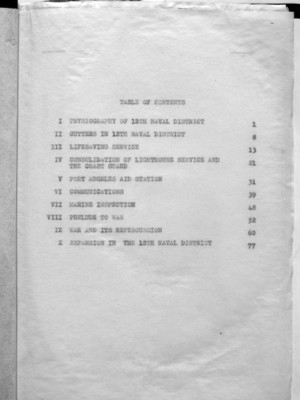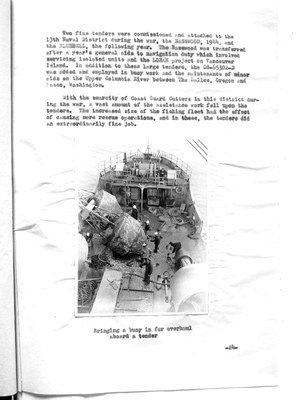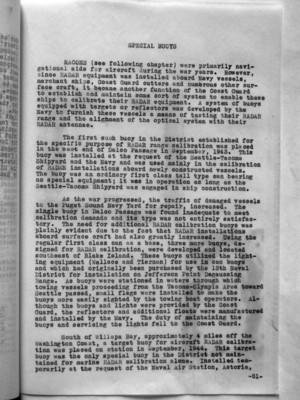Pages That Mention Cutters
Coast Guard District narrative histories 1945
3
TABLE OF CONTENTS
I PHYSIOGRAPHY OF 13TH NAVAL DISTRICT 1 II CUTTERS IN 13TH NAVAL DISTRICT 8 III LIFESAVING SERVICE 13 IV CONSOLIDATION OF LIGHTHOUSE SERVICE AND THE COAST GUARD 21 V PORT ANGELES AND STATION 31 VI COMMUNICATIONS 39 VII MARINE INSPECTION 48 VIII PRELUDE TO WAR 52 IX WAR AND ITS REPERCUSSION 60 X EXPANSION IN THE 13TH NAVAL DISTRICT 77
7
Two fine tenders were commissioned and attached to the 13th Naval District during the war, the BASSWOOD, 1944, and the BLUEBELL, the following year. The Basswood was transferred after a year's general aide to navigation duty which involved servicing the isolated units and the LORAN project on Vancouver Island. In addition to these large tenders, the CO-65302-D was added and employed in buoy work and the maintenance of minor aids on the Upper Columbia River between The Dalles, Oregon and Pasco, Washington.
With the scarcity of Coast Guard Cutters in this district during the war, a vast amount of the assistance work fell upon the tenders. The increased size of the fishing fleet had the effect of causing more rescue operations, and in these, the tenders did an extraordinarily fine job.
(Photo inserted here)
Bringing a buoy in for overhaul aboard a tender
-24-
71
SPECIAL BUOYS
RACONS (see following chapter) were primarily navigational aids for aircraft during the war years. However, since RADAR equipment was installed aboard Navy vessels, merchant ships, Coast Guard cutters and numerous other surface craft, it became another function of the Coast Guard to establish and maintain some sort of system to enable these ships to calibrate their RADAR equipment. A system of buoys equipped with targets or reflectors was developed by the Navy to furnish these vessels a means of testing their RADAR range and the alignment of the optical system with their RADAR antennae.
The first such buoy in the District established for the specific purpose of RADAR range calibration was placed in the west end of Dalco Passage in September, 1943. This buoy was installed at the request of the Seattle-Tacoma Shipyard and the Navy and was used mainly in the calibration of RADAR installations aboard newly constructed vessels. The buoy was an ordinary first class tall type can bearing no special equipment; it was in operation as long as the Seattle-Tacoma Shipyard was engaged in ship construction.
As the war progressed, the traffic of damaged vessels to the Puget Sound Navy Yard for repair, increased. The single buoy in Dalco Passage was found inadequate to meet calibration demands and its type was not entirely satisfactory. The need for additional RADAR calibration buoys was plainly evident due to the fact that RADAR installations aboard surface craft had also greatly increased. Using the regular first class can as a base, three more buoys, designed for RADAR calibration, were developed and located southeast of Blake Island. These buoys utilized the lighting equipment (Wallace and Tiernan) for use in can buoys and which had originally been purchased by the 13th Naval District for installation on Jefferson Point Degaussing Range. As buoys were stationed in waters through which towing vessels proceeding form the Tacoma-Olympia Area toward Seattle passed, small flags were installed to make the buoys more easily sighted by the towing boat operators. Although the buoys and lights were provided by the Coast Guard, the reflectors and additional floats were manufactured and installed by the Navy. The duty for maintaining the buoys and servicing the lights fall to the Coast Guard.
South of Willapa Bay, approximately 4 miles off the Washington Coast, a target buoy for aircraft RADAR calibration was placed on station in September, 1944. This target buoy was the only special buoy in the District not maintained for marine RADAR calibration alone. Installed temporarily at the request of the Naval Air Station, Astoria,
-51-


